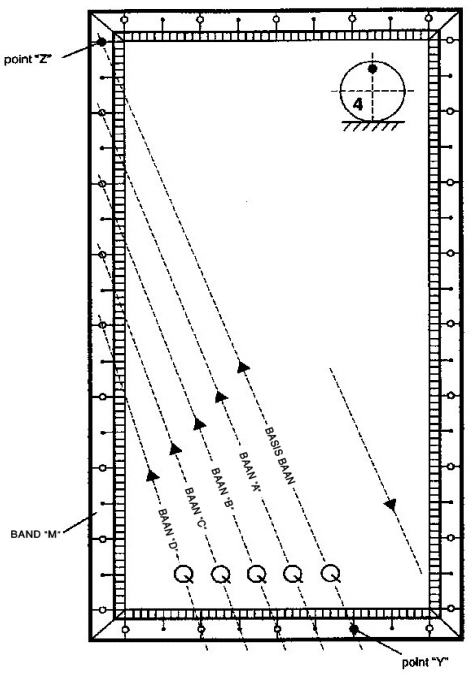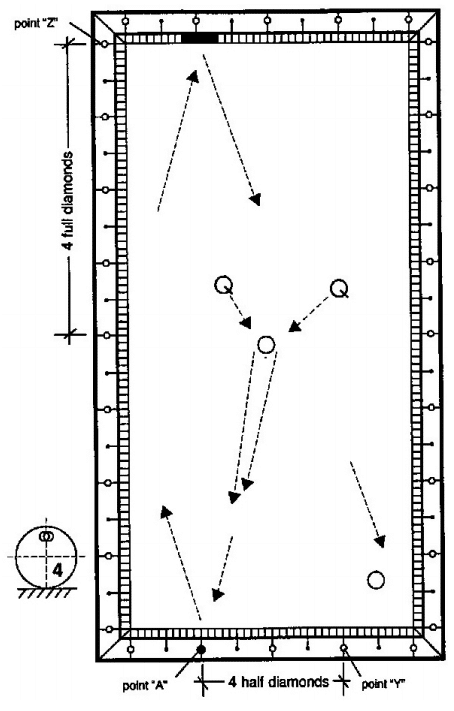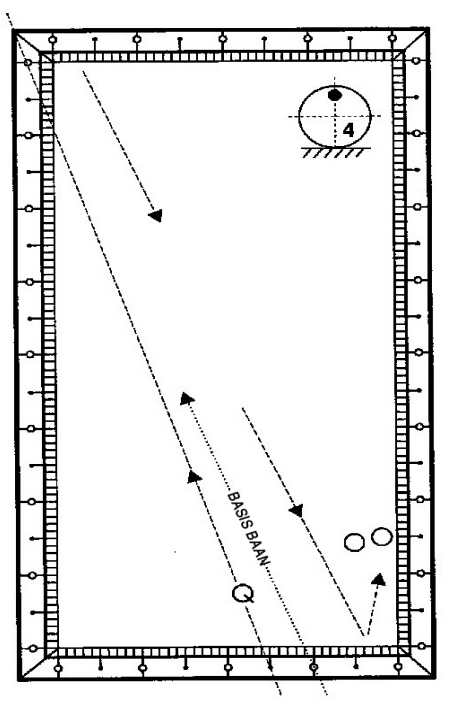40 Euro System 3 Cushion Billiards Lessons
The isolated running line of the ball without side effect 3 cushion billiards systems
If I come from point “Y” with my cue ball and aim,
with overshoot effect on point “Z”,
the cue ball will follow the running line as shown in the drawing …
and this will be called the baseline.
If your material or disposal is different,
then try to let your cue ball depart from the shaded area at band “P”.
The condition of the balls makes a big difference, so practice this test shot often.
If the “seven band speed” is used, the cue ball moves to the right of point “Y”.

The New York Bob system 3 Cushion Billiards
Once the original starting point of the cue ball has been determined for this figure (as shown on the previous page) then you can use a system called “New York Bob” if the cue ball is in a bad position.
Let’s assume the balls are new and the billiard cloth from a recent date and your cue ball base is now point “Y”.
For every HALF DIAMOND that the cue ball changes from its origin to the left of point “Y” then the adjustment on band “M” is ONE DIAMOND away from point “Z” … see running lines “A”, “B”, “C “and” D “…
The cue ball is on running line “D” four half diamonds away
from point “Y” … so four full diamonds from point “Z” is the
adaptation to band “M”.
In the following pages are two excellent examples of how to use this method.



The 40 Euro system 3 Cushion Billiards
The professionals play this figure well,
I’ll bet most players won’t be able to accurately find the required hitting points for this running line …
Here is the method … look at the figure and estimate the tangent point on the first band (point “A”) … then look behind this point and calculate the tangent point on the long band, using the principles described on the previous one pages are shown … once this is established, then estimate the point on the last band. (the shaded area on the third band). With this, the entire running line is easily completed.
You know that a cue ball running from point “Y” to point “Z” will end close to ball three … point “A” is four half diamonds away from point “Y” … So the aiming point is on the long band four full diamonds away from point “Z” … easy isn’t it? …
The cue ball can land on either side of ball two … with height effect you will achieve a small change, so experiment.


The effect given to the cue ball is extremely important.
In the video, you can see the cue ball going to irregular places in the first cushion. But in the fourth band, it went within tolerance.
The reason I shot such shots was to show that the main thing was the effect.
So, in order to get efficiency from this system, it is necessary to do an effect study first.
If the shot is too thick, it may be necessary to give the opposite effect.
Try to understand the going and return angles of the cue ball in the second band. (band=cushion)
When we give an effect from the upper part of the cue ball (12 o’clock), it can elongate hard hits. This elongation can be prevented by hitting from below.
In this type of shooting, professional players love when the arrival ball stops in an advantageous, ie tolerant zone.
It is one of the important systems to continue running in bad positions.
To summarize, the whole point is that the cue ball touched the shooting ball. The angle that goes on the first band is a symbol that needs to be experimented a lot, at what angle it should go on the second band.
In this system, effect determines everything.
Exercise is essential to success in 3-cushion billiards systems.
If a position in the match puts you under pressure, it indicates that you are not exercising as much as necessary.
It may take time to be successful in some 3 cushion billiard systems. No english shots.













